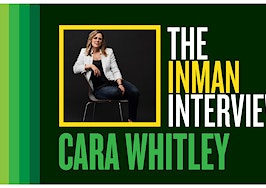 September is Marketing and Branding Month at Inman. That means we’re talking to the chief marketing officers at major brokerages about how the pandemic is changing their jobs and what it means for agents. We’re publishing a suite of tactical Inman Handbooks for marketing on digital portals. And we’re looking at what pages of the traditional marketing playbook still work. Join us all month long.
September is Marketing and Branding Month at Inman. That means we’re talking to the chief marketing officers at major brokerages about how the pandemic is changing their jobs and what it means for agents. We’re publishing a suite of tactical Inman Handbooks for marketing on digital portals. And we’re looking at what pages of the traditional marketing playbook still work. Join us all month long.
A marketing calendar can be a lifeline to any broker in order to keep track of goals and release information in an organized, strategic and consistent way. It can help brokers keep track of specific messaging and what channels will be used to spread that messaging. And most importantly, keeping an effective schedule can greatly improve lead generation and sales.

Julie Del Santo
“The consistency of my marketing calendar — it directly relates to the number of transactions I have,” Broker/Owner of Dudum Real Estate Group Julie Del Santo told Inman.
According to all-in-one content marketing platform CoSchedule, 35 percent of content marketers publish weekly content. But, 91 percent of the most successful businesses publish content at least on a weekly basis or more frequently.
Regardless of how often you decide to push out content online or in a good old paper, here are the steps you’ll want to consider for developing an effective marketing schedule.
1. Designate a team for brainstorming, scheduling and creating content.
Narrow down what kind of roles you’ll need for the different types of content you want to create, and brainstorm who might have the best skills to fit those roles. This might consist of one person or a handful of people depending on how large your brokerage is. Then discuss what’s realistic in terms of how often each person can create new content, and build these timelines out in your schedule. “Every November I sit with my marketing team and I say, ‘OK, what are we doing?'” Del Santo said. “‘What are we gonna mail when?'”
2. Identify your target customer and how you want your marketing to shape your relationship.

Sara Nay
“The first step to building a marketing calendar is to take a step back and think about your customer journey,” Sara Nay, chief operating officer at small business marketing consultant Duct Tape Marketing, told Inman. Think about how you can use your marketing content to be found, then wield that content to develop relationships with your clients, whether you think of “clients” as agents you’re trying to recruit or homebuyers or sellers you’re hoping to attract.
3. Start with a 12-month calendar and chart out seasonal changes, events, themes and planned marketing materials for the year.
The housing market certainly adapts with the seasons, and so should your marketing schedule. Note what kinds of trends you see in your buyers and sellers at different points throughout the year, and determine how you’ll address those in your marketing. Use themes to address areas of opportunity, in your market specifically, and according to the times, and make a note of them on the calendar. Duct Tape Marketing recommends developing three core themes and nine supplemental themes for the year, then matching those themes with SEO keywords for online marketing. Make notes on specific dates of your calendar for what kind of marketing materials you’ll make throughout the year to hold yourself accountable for producing content at regular intervals.
4. Diversify your marketing strategy.
The combination of her four-pronged approach of hard mailers, e-blasts, social media and personal outreach is what Del Santo says helps keep her at the top of her agents’ and clients’ minds alike. Although many agents and brokers shifted to a mindset that favors e-marketing to paper marketing about 5 to 10 years ago, Del Santo says e-marketing is “what I call ‘gravy’ — it’s just added bonus on top” of hard mailers and personal calls or interactions with clients that will make a bigger impact on them in the long-term.
5. Schedule in check-in points on your calendar to track what progress you’ve made toward your goal.
Are your strategies working? Be sure to check in on the results of social media campaigns, as well as events and other marketing pieces, to see what actually seems to be giving you results. It might be helpful to set up reminder alerts in your Google, Outlook or other primary calendar at periodic intervals to check your progress. Make notes, and try a different tactic if something doesn’t seem to be working.
6. Take advantage of tech.

Tara Siegel
There are plenty of different marketing calendar templates and programs out there to explore, but something as simple as using a shared Google calendar or sheet could work. Given the times that we live in, though, your marketing should have a palpable digital presence, even if it’s not the primary focus. “Marketing and communications schedules must be digital, and must include a strong long-term strategy, which, to us at Lewith & Freeman, means a strong SEO strategy,” Tara Siegel, vice president of marketing at Lewith & Freeman Real Estate, told Inman. “SEO impacts can take months to show themselves, so having a long-term plan and schedule for web and SEO improvements has proven to be a successful strategy.”
7. Be flexible.
If the pandemic’s taught us anything, it’s that things can change within a business and within the world pretty quickly. Therefore, any marketing schedule “must be accessible and flexible,” Siegel said. “As we know, the market, social and economic climates change often and swiftly. It’s important when creating a communications and marketing strategy to include room for customization and flexibility.” Del Santo added that a marketing calendar often won’t need major changes once it’s set, but you should be prepared to “make the shift as needed” when something like a pandemic disrupts daily life in a big way.
8. Don’t forget one-on-one outreach.
Del Santo told Inman that reaching out to individuals either on the phone or in-person, “in my opinion, is the most important part.” With social media, it’s easier now than ever to see when people experience big life events, which creates an opportunity for some personal outreach. “When you see on social media someone had a baby, go drop off a meal,” Del Santo said.





